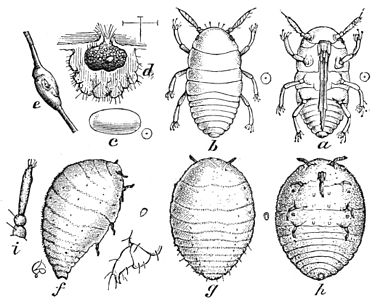they lose their globular tips and become more or less worn with age. Issuing from the mouth of the gall, these young lice scatter over the vine, most of them finding their way to the tender terminal leaves, where they settle in the downy bed which the tomentose nature of these leaves affords, and commence pumping up and appropriating the sap. The tongue-sheath is blunt and heavy, but the tongue proper––consisting of three brown, elastic, and wiry filaments, which, united, make so fine a thread as scarcely to be visible with the strongest microscope––is sharp, and easily run under the parenchyma of the leaf. Its puncture causes a curious change in the tissues of the leaf, the
Fig. 3.

Type Gallæcola.—a, b, newly-hatched larva, ventral and dorsal view; c, egg; d, section of gall; e, swelling of tendril; f, g, h, mother gall-louse—lateral, dorsal, and ventral views; i, her antenna; j, her two-jointed tarsus. Natural sizes indicated at sides.
growth being so stimulated that the under side bulges and thickens, while the down on the upper side increases in a circle around the louse, and finally hides and covers it as it recedes more and more within the deepening cavity. Sometimes the lice are so crowded that two occupy the same gall. If, from the premature death of the louse, or other cause, the gall becomes abortive before being completed, then the circle of thickened down or fuzz enlarges with the expansion of the leaf, and remains (Fig. 2, c) to tell the tale of the futile effort. Otherwise, in a few days the gall is formed, and the inheld louse, which, while eating its way into house and home, was also growing apace, begins a parthenogenetic maternity by the deposition of fertile eggs, as her immediate parent had done before. She increases in bulk with pregnancy, and one egg follows another in quick succession, until the gall is crowded. The mother dies and shrivels, and the young, as they hatch, issue and found new galls. This process continues during the summer until the fifth or sixth generation. Every egg brings forth a fertile female, which soon becomes wonderfully prolific. The
